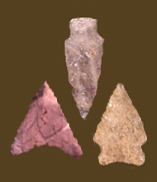
|
VERNON
The Vernon is a short, wide, and thick point with pronounced shoulders and an expanded stem, and with a base that is usually straight. Chronology There is disagreement on the age of the Vernon point. Stephenson and Ferguson (1963) indicate that it is an Early Woodland period type, found in association with Marcey Creek pottery and Calvert points at the Accokeek Creek site. Others, noting its similarity to -- if not outright identity with -- the Halifax point, place it early in the Late Archaic period (LeeDecker and Koldehoff 1991; Dent 1995). A radiocarbon date of 5120 +/- 160 BP (approximately 3950 BC in calendar years) was obtained on two Vernon points found at the Jeffrey-Harris Rock Shelter site along the Potomac River in Virginia, which is contemporary with Halifax points dated elsewhere (Johnson 1968). McNett and Gardner (1975) suggest the Vernon is younger than the Piscataway but older the Bare Island/Holmes. LeeDecker and Koldehoff (1991) suggest a Vernon date range of approximately 5500 to 4300 BP, while Steponaitis (1980) uses 5000 to 4000 BP. Ebright (1992) suggests the type began in the Late Archaic period but continued in use well into the Early Woodland. Description Blade: The blade is typically a wide, squat triangle with convex edges and a sharp point. It is thick and irregular in cross section. The shoulders are prominent, and usually are at an obtuse angle to the stem. Haft Element: The stem constitutes 30 to 40 per cent of the total point length, and usually has an oval cross section. It constricts from the shoulders to the midpoint of the stem, and then expands to a wide base. The base is usually straight, but in some specimens is slightly convex or concave. Size: Length ranges from 24 to 49 mm, with an average of 37 mm. Width ranges from 16 to 30 mm, with an average of 23 mm. Thickness ranges from 6 to 13 mm, with an average of 10 mm. Technique of manufacture: Crudely to moderately well-made by percussion chipping, and typically finished by pressure flaking along the edges or occasionally over all surfaces. Material: In a sample of 551 Vernon points from the lower Patuxent drainage, Steponaitis (1980) reported that 88% were quartz, followed by quartzite (7%), rhyolite (4%), and chert (1%). In the area surrounding Zekiah Swamp on the lower Potomac, Wanser (1982) found that 84% of 700 Vernon points were quartz, with 8% rhyolite, 7% quartzite, and small numbers of jasper, chert, and other materials. At the Accokeek Creek site in Prince Georges County, approximately 75% of the 423 specimens were quartz, while 25% were quartzite and a few were made from other materials (Stephenson and Ferguson 1963). Of the 38 Vernon/Halifax points excavated at the Indian Creek V site in Prince Georges County, 33 were quartz, while the rest were quartzite, rhyolite, or argillite (LeeDecker and Koldehoff 1991). In the Monocacy River drainage, 45% of 60 Vernons were rhyolite, with 38% quartz, 13% jasper, and 4% quartzite (Kavanagh 1982). In the middle Potomac Valley, quartz, quartzite, and rhyolite are predominant (Hranicky 2002). Discussion Defined in Literature This type was originally defined by Stephenson and Ferguson (1963) based on points recovered from the Accokeek Creek site in Maryland. References |
![]()
Search by Shape:
(See Projectile Point Typology) |

|
Thank you for visiting our website. If you have any
questions, comments, Copyright © 2002 by |

|

 Defining Attributes
Defining Attributes